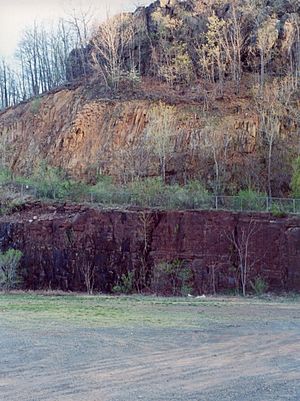Shuttle Meadow Formation facts for kids
Quick facts for kids Shuttle Meadow FormationStratigraphic range: Hettangian ~201–199Ma |
|
|---|---|

Talcott Formation over Shuttle Meadow Formation in a quarry (Connecticut)
|
|
| Type | Geological formation |
| Unit of | Newark Supergroup Meriden Group |
| Underlies | Talcott Formation |
| Lithology | |
| Primary | Black shale |
| Other | Siltstone |
| Location | |
| Coordinates | 41°24′N 72°42′W / 41.4°N 72.7°W |
| Approximate paleocoordinates | 22°06′N 19°30′W / 22.1°N 19.5°W |
| Region | New England |
| Country | |
| Extent | |
The Shuttle Meadow Formation is a special layer of rock found in Connecticut and Massachusetts, USA. It was formed during the Mesozoic Era, which is often called the "Age of Dinosaurs." Scientists study this rock layer to learn about Earth's past and the creatures that lived long ago.
Contents
What is the Shuttle Meadow Formation?
The Shuttle Meadow Formation is a type of rock formation. Think of it as a giant, ancient stack of dirt and mud that turned into rock over millions of years. It is part of a larger area called the Hartford Basin. This basin is a big, bowl-shaped dip in the Earth's surface.
Where Can You Find It?
You can find this rock formation in parts of Connecticut and Massachusetts. These areas were once very different from how they look today. Millions of years ago, this region had lakes and rivers where these rocks were formed.
What is it Made Of?
The Shuttle Meadow Formation is mostly made of two types of rock:
- Black shale: This is a dark, fine-grained rock. It forms from mud that settles at the bottom of lakes or slow-moving water.
- Siltstone: This rock is similar to shale but has slightly larger grains. It forms from silt, which is like very fine sand.
These rocks tell us that the area was once covered by water, possibly a large lake.
Amazing Fossils Found Here
One of the most exciting things about the Shuttle Meadow Formation is the fossils found inside it. Fossils are the preserved remains or traces of ancient life. Scientists have discovered some incredible things here:
- Insect Fossils: Tiny insects like Mormolucoides articulatus have been found. These fossils help us understand what insects looked like millions of years ago.
- Dinosaur Remains: Even dinosaur fossils have been recovered! One example is Coelophysis sp., which means a type of Coelophysis dinosaur. Finding dinosaur bones helps us learn about the types of dinosaurs that roamed this area during the Mesozoic Era.
These fossils are like clues that help scientists piece together the story of Earth's ancient past.

